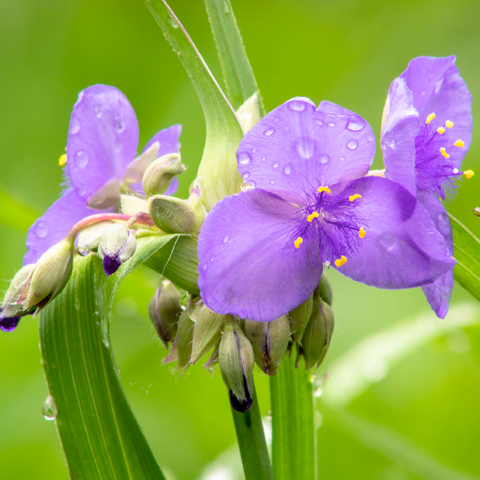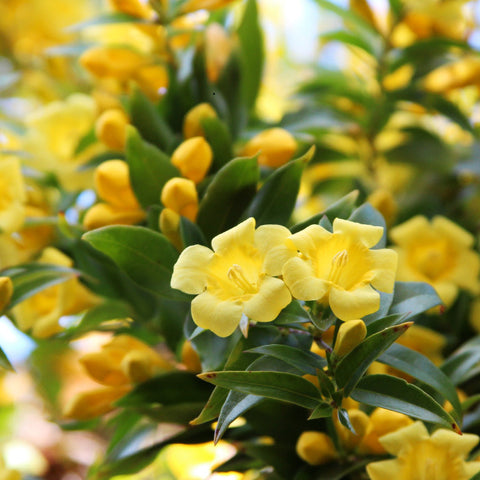Bringing native plants into your garden or landscape design is a wonderful way to support local wildlife. Our backyards can provide an assortment of food and shelter for bees, birds, butterflies, and plants — sustaining nature’s delicate balance of flora and fauna.
A wide range of native garden plants encourage healthy insect communities including our favorite pollinators, the honey bees. A variety of Insects are key to a healthy garden. They break down organic matter, control pests, and keep birds well fed. When birds are thriving, they help fertilize the soil, reduce weeds, and spread the seeds of native plants.
As caretakers of our home garden, the gift of native plants is low maintenance care with high rewards. Not only do indigenous plants remain vibrant year-round, they are non-invasive and preserve biodiversity in your region.
Choosing Native Plants that Bees Love
Luckily, bees aren’t very hard to please when it comes to flowers. But we’ve got some tips to make your garden irresistible to bees.
- Grow flowers with flat, open blossoms that make it easy for bees to access nectar.
- Choose blossom colors wisely. With unique vision abilities, honey bees only see the colors purple, blue, white, yellow and ultraviolet light.
- Include your favorite culinary herbs — sage, thyme, lavender, chives, dill, basil, oregano, rosemary, and mint. They are all bee-friendly once they flower.
- Plant a mix of annual and perennial flowers so that your garden has flowers in bloom all season long.
The Differences Between Perennials and Annuals
Perennial plants live for three or more growing seasons, while annuals sprout, flower and expire all in the same year.
Perennials are less work than annuals because they grow back each year from roots that go dormant in the winter. Although they can bloom every year, perennials invest more energy into their roots. Annuals have a shorter lifespan, but they grow quickly and yield vivid colors that bloom all season long.
Native Plants by Region
Below, you’ll find our top picks for bee-friendly plants native to the major regions of the US.

The Pacific Northwest
Common harebell: Although whimsical in appearance, the harebell is resilient. The bell shaped blue-violet flowers are an easy-to-grow perennial that blooms in mid-summer to early autumn.
Yarrow: With flat-topped clusters of white, With flat-topped clusters of white, fragrant flowers, yarrow grows to 3 feet tall and bloom nearly all summer. The essential oil is an unusual dark blue hue.
Showy Fleabane: Abundant daisy-like, bluish lavender blossoms with an impressively long summer bloom time, the showy fleabane is popular with pollinators. By autumn, the flowers mature into fluffy white seed heads.

The Rocky Mountain Region
Blanketflower: This long-blooming wildflower with a multitude of cheery flower heads blossoms from early summer until the frost comes. A magnet for native bees, the bristly hairs covering its foliage make it deer- and rabbit-resistant.
Lyreleaf Greeneyes: Daisy-like yellow flowers with an earthy chocolate scent, the lyreleaf greeneyes blooms from spring to when the first frost hits. The lime-green seedbeds are decorative but don’t last long, as songbirds avidly eat the papery seeds.
Soapweed Yucca: Beloved for its spiky, punk-rocker silhouette and dramatic flower stalks with waxy, fragrant blossoms, this long-lived shrub tolerates cold and drought and grows up to 6 feet tall. Its bell-shaped, downward-hanging flowers provide abundant nectar and pollen.

The Midwest
Hoary Vervain: Described as having a purple or lavender hue, hoary vervain is a welcome contrast to the many yellow and orange flowers common on the prairie.
Gray-Headed Coneflower: Tall and graceful, this prairie plant will sway in the breeze and intertwine with its neighbors, unlike some other prairie flowers. Blooming all summer, this perennial attracts many pollinators.
Spiderwort: Charming, versatile spring-blooming perennials, spiderwort displays grassy foliage and three-petaled flowers.

The Northeast
Flowering Spurge: Abundant white blossoms open in midsummer and last for several weeks. Flowering spurge is tame, but it does spread well and forms an open, airy mat in poor, dry soils where many other perennials struggle.
Pinxterbloom Azalea: Flower color varies from light to dark pink; blossoms open with a delicate, sweet fragrance after leaves start to unfurl in spring.
Woodland Iris: A blue-violet iris that flowers cover the grassy clumps of foliage in late spring. Several varieties are available and form fast-spreading (but non-aggressive) clumps within a few seasons.

The Southeast
Southern Magnolia: A large tree with impressive evergreen foliage, the deep, glossy green leaves with rusty red undersides and the autumn fruit make this tree a great ornamental specimen even when it’s not in flower.
Beautyberry: Recently en vogue among native-plant enthusiasts, it’s easy to grow, spreads well and provides a unique splash of bright purple fruit in autumn. An excellent wildlife food plant, because it attracts pollinators in spring and birds in autumn.
Carolina Jessamine: A vigorous flowering evergreen vine without being invasive, its twining stems need support to wrap around and climb. It’s perfect for a trellis, an arbor or against a wall face. One of the earliest spring bloomers, Carolina Jessamine displays a pop of yellow when other plants have yet to break their dormancy.

The Southwest
Pink Fairy Duster: A low-growing shrub that brings the desert landscape to life in winter with splashes of pink with blooms that resemble a small feather duster. Flowering lasts into spring and occasionally reoccurs in fall.
Yellow Bells: Tropical-looking, yellow-flowering shrub with large, trumpet-shaped flowers of yellow bells against bright green foliage. The blooms begin to appear soon after the last frost in spring and continue blooming nonstop until just before the first frost in the fall. The golden-yellow blooms are a favorite of hummingbirds and bees alike.
Santa Rita Prickly Pear: Some of the most iconic cacti, they have distinctive paddle-shaped leaves, vibrant flowers and tiny, bristly hairs. The colorful, purple-tinged gray-blue pads appear in response to drought and cold temperatures, while yellow flowers appear in spring.
Everbee: A Bee Haven for Every Garden
Even with the best of intentions, your bee-friendly garden may experience a dearth period — an unavoidable nectar shortage during spring and summer that can threaten the survival of an entire bee colony.
What can we do?
A reliable food source all season long, Everbee is the first bee feeder to deliver essential nutrients to bees while removing their top threat, the Varroa mite. Once inside Everbee, the bees are dusted with our Protect™ powder to help them remove the dangerous parasite, leaving bees healthier with every visit.
Placed in your garden or backyard, Everbee is sure to make local honey bees the happiest in your ‘hood.


 May 24, 2022
May 24, 2022 Posted by: Kim West
Posted by: Kim West